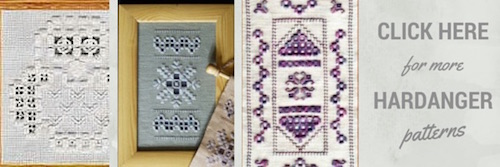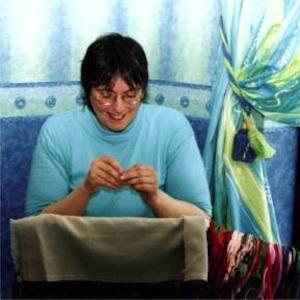- Home
- Beginner Guide to Hardanger
Lesson 2 of the beginner guide
to Hardanger embroidery
Have you completed the first project in the beginner’s guide to Hardanger embroidery free course? If so, congratulations! You’re ready to move on to the next stage.
In this lesson, we’ll create a charming design that introduces three key stitches: side-by-side Kloster blocks, wrapped bars, and dove’s eyes.
Let’s get started!
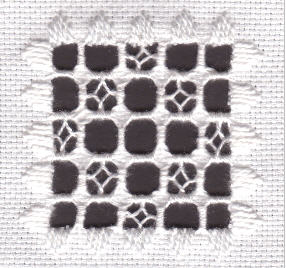
Materials You’ll Need
- Fabric: An 8-inch square of Hardanger 22-count fabric
- Thread: Pearl cotton nos. 5 (thicker) and 8 (thinner)
- Needles: Tapestry needles, sizes 22 and 26
- Embroidery Hoop: A wooden 6- or 8-inch hoop works best
Before beginning, download the Hardanger pattern for this lesson. It’s a PDF file, which you can open using Adobe Reader or Preview on a Mac.
Step 1: Stitching the Kloster Blocks
Find the Center of the Fabric:
Fold your fabric in half both ways and lightly crease the center. From the center, count up 19 threads and two threads to the left to find Point A on your downloaded chart.
Start Stitching
Thread your needle with pearl cotton no. 5 and tie a temporary knot at the end. Push the needle through from the front, leaving the knot on the surface of the fabric (outside your stitching area). This knot won’t stay in the final piece.
Work the first five satin stitches as numbered on your chart, stitching over the following pattern of fabric threads: 4, 5, 6, 5, and 4.
Miss four threads and start the next block, repeating the stitch sequence. Carry the thread diagonally across the back between blocks as you work along each side of the motif.
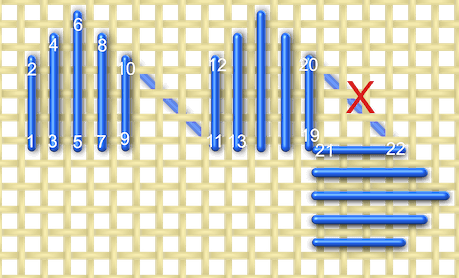
When you reach the corner, reuse hole 19 and take the next stitch out to the side as shown. This avoids having a diagonal thread across the corner marked with a red X in the diagram above.
Managing the Thread
If your thread runs short, complete the current block before joining a new thread. Starting a new thread mid-block will show, because worn thread appears less shiny than fresh thread.
Once all Kloster blocks are complete, your project should look like the example photo below.
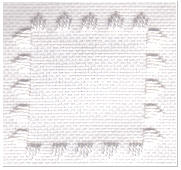
Step 2: Cutting the Fabric Threads
Take a deep breath—this is the step that makes everyone nervous! With sharp, pointed scissors:
- Locate the fabric threads to cut using the red lines on your chart.
- Slide the scissor blade under four adjacent threads, double-check your count, and cut in one movement.
- Cut close to the satin stitches, but don’t worry about small tufts. These will settle into the satin stitches after washing.
Your piece should now have neatly cut and withdrawn threads, ready for the next stage.
Only cut threads at the end of the satin stitches, not alongside them!
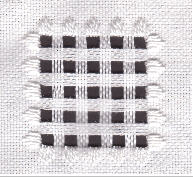
NOTE: It is safest to slide the scissor blade underneath all four adjacent threads at once, then double check that you only have four, before cutting them in one movement.
Step 3: Working the Overcast (Wrapped) Bars
Now, we’ll wrap the remaining fabric threads to create a neat grid for the openwork.
Re-thread Your Needle: Use pearl cotton no. 8 for this step.
Wrap the Bars: Pull the four fabric threads together firmly, wrapping the thread over and under them. Ensure the wraps lie flat beside each other, not overlapping. Count your wraps on the first bar and maintain this number on the rest of the bars for consistency.
Moving Between Bars: At the end of each row, pass the needle through the back of the nearest Kloster block to reach the starting point for the next diagonal row.
I've marked the bars that complete squares in green on your chart. These indicate where you'll need to do a doves eye stitch. Before we cover those instructions, wrap half of your first green bar.
Step 4: Stitching Dove’s Eyes
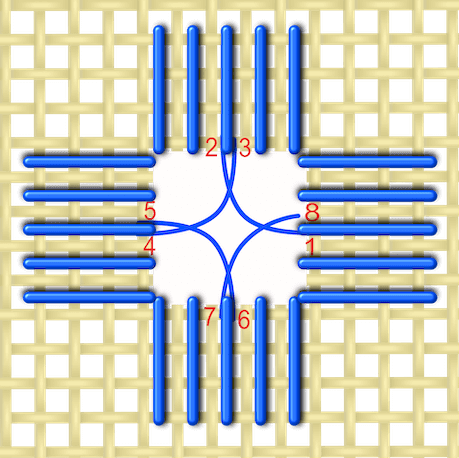
The dove’s eye is a beautiful filling stitch formed by four buttonhole stitches inside the hole left after cutting the fabric threads. The edges of the hole may consist of either kloster blocks, wrapped bars, or a cominbation of both.
Begin by wrapping half of a green bar on your chart, the bring the needle up in the centre of the hole.
Take the needle under the adjacent bar or kloster block (you can work clockwise or anti-clockwise). Bring the needle back up inside the loop you have just made, pulling the loop into shape until it fits comfortably (not loose but also not stretched too tight). Repeat this process until you reach the bar you were halfway through working.
To complete the stitch, take the thread under the first loop you made and back down into the middle. Then finish wrapping the fourth bar. Try to make all your dove's eyes the same size with the same amount of tension.
It is important to make sure that all four loops in the dove's eye cross in the same direction to keep things neat.
Finishing your project
Congratulations! With this stage complete, your Hardanger embroidery piece is ready to use. Here are a few ideas for using your work:
- Turn it into a coaster
- Mount it into an aperture card
- Create a pincushion with a satin lining
- Make a Christmas tree ornament
We’d love to see your finished projects—feel free to share a photo!
Hardanger embroidery is a rewarding craft, and with practice, you’ll grow more confident in your skills.
Keep stitching, and enjoy the process!
Stay connected between projects
If you’d like occasional updates from my embroidery room, including new patterns, gentle tips, and little things I think you might enjoy, you’re warmly invited to join the Stitchin’ Times newsletter.
No pressure. Just a friendly note now and then to keep you inspired.
